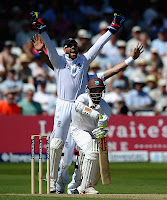 |
| Broad: too cool for school |
1. WE DON’T NEED NO EDUCATION
For some people, the idea of leaving school at the age of 14
without qualifications doesn’t matter so much. Gangsters, for instance. Or professional
sportsmen, particularly those at the top level. So it was that Stuart Broad,
having last night used Twitter to try and generate some walk-up ticket sales
for Trent Bridge – not an easy sell given that, at that start of play, West
Indies were only 3 runs ahead with 3 left in the shed – this morning sent this
message to his 294,012 followers (of which, some quick research tells us,
147,876 are impressionable under-16s): “Exams are no excuse. Come to Trent Bridge
So, not only is he playing down the importance of education,
he’s also encouraging under-age drinking. #Scandalous.
By some unfathomable coincidence, Broad’s Nottinghamshire
teammate, Graeme Swann, tweeted to his much more robust following of 379,775:
“make sure you all come down to Trent Bridge tomorrow. Day 4 promises to be a
corker and we love a full house”. Notts’ marketing department will be delighted
these two did this entirely off their own bats.
Despite having a fringe that a caricaturist would require a
ruler to draw, Marlon Samuels’ contribution was very well rounded: 2 for 14 first dig, the only wicket in the second, 117 and
76 not out. Along the way, however, he received a few snipes for not moving his
feet enough when driving (much like my Grandma on her Sunday jaunt to the Peak
District), judgements seemingly based on Pathé News footage of Len Hutton’s
cover drive.
Let me dispel a myth. There is no such thing as technical perfection;
no way you can get everything ‘right’. There is only risk management,
concealing your weaknesses. You elaborate a method that has its pros and its
cons, a method that may vary in step with the transformation of the conditions
(overhead and underfoot), the situation, the attack, your own vibe. Sometimes
these technical quirks and adjustments become sedimented into habit, into a
technique.
Yes, Samuels often drives with feet together, especially
against the quicker bowlers, but he also manages to leave the ball this way,
too – an elaborate leave, it has to be said, one that occasionally takes him
two pitches down the square to the offside, like a latter day Courtney Walsh.
In these conditions, once the lacquer had come off the new ball, it seemed
evident that the major danger to the batsman was straight bowling thudded into
the wicket on an in-between length (hence the six lbws). Therefore, not lunging forward (there is also the
bouncer to think about, remember) on a wicket that was not really seaming
seemed a fairly sensible approach to the game, especially in a post-DRS
universe in which the Stride Defence is no longer what it used to be.
3. ROACH CLIP
Where England Lions managed to see off West Indies by 10
wickets in the East Midlands (Northampton ),
the big boys only managed a nine-wicket win. At times, England were stretched, but they
look in pretty fine fettle, having answered a couple lingering questions over
the team’s make-up. After an indifferent opening day, Bresnan’s ultimately
commanding contribution to the game (8 for 141 and 39 not out) probably cemented
his spot – even though Strauss was coy about possible rotation – just as had the
skipper at Lord’s, leaving only the number 6 position as an uncovered base.
Johnny Bairstow had pushed himself to the front of the queue
with early-season runs, but now must convince the hierarchy that his discomfort
against Roach’s bouncers was a one-off moment in the headlights, and that the
carrot-topped one’s carrot eating doesn’t mean he’s a rabbit, in either a cricketing sense or a tortuous metaphorical
headlight-averse sense, headlights of course being Kemar’s bouncers. Phew!
5. ENGLAND
With the aforementioned Lions game having thrown forward yet
another cricketer of promise in the form of Joe Root (a chat-up line in parts
of Dudley), it has occurred to Spin that,
with Australia here for a
brief limited-overs exercise in cynical workhorse-flogging series, England
could rest their whole side and put out an ‘A’ Team. Better still, make it a
triangular tournament, with two Englands
and an Australia ,
pay back for the 1994-5
Benson and Hedges Series Down Under in which the hosts thought their second
string were needed to provide more competitive cricket. They were right, of
course, but it would be gratifying to think that England and their cubs could do the
same.
 |
| Chef supreme |
6. STRAUSS AND COOK
During the fourth innings chase, England ’s openers completed 5000
Test runs in tandem, scarcely breaking sweat (literally in Cook’s case) in
chalking off the 108 runs required. Some of those have been made with Cook at
first drop, but this pair of southpaws have made over 4500 runs together as
openers (according to Malcolm Ashton, anyway), moving them past Atapattu and
Jayasuriya into third, with only the Langer-Hayden and Greenidge-Haynes duos
above them. It’s not always pretty, but it’s a pretty decent effort, that, and
well deserved for a couple of honest fellows.






















